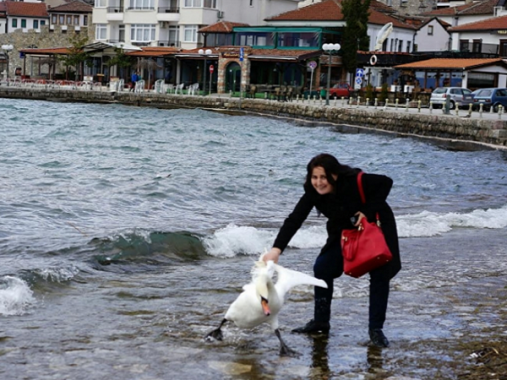The story about the swan in Ohrid: Bush telegraph and adorned information
Published in Journalistic Lessons
on 21 - 03 - 2016 Author: Димитар Тануров
- One photo, plethora of speculations. The story about the Ohrid swan was republished by the world media as well. Photo: Nakje Batev, used with permission.
The whole Ohrid swan case and the way the information was distributed, only points out to the significance of the language in the news articles – the language ought to be clear, precise and comprehensive
Author: Dimitar Tanurov
“The world is the totality of facts, not of things, and words serve to signify facts” – Ludwig Wittgenstein’s quote seems as it is was written having the journalists in mind.
A single picture is worth 1000 words, but one inaccurate description or omitted punctuation can lead to a completely incorrect story. That’s exactly what happened with the photo-news about the Ohrid swan. This information was first published by the “Vecher” daily, with the title: “Tourist shows rare type of rudeness in Ohrid: She killed the swan in order to take a picture with it”. And this is how the entire chaos began.
This article, which is a description and a comment on the photo-news about the harassed swan, does not mention murdering the bird, however, the title contains the informal phrase “killed it” meaning “injured it”, but without quotation marks. This is the point where the whole ”bush telegraph” thing started, and not only it alleged that the swan is dead, but also maintained that the whole case was for a selfie, which allegedly appeared on social media, and even that the tourist is a Bulgarian citizen. By omitting the quotation marks, the articles actually gave false information.
AN ASSUMPTION THAT TURNED INTO ASSERTION
The original article, published on March 4 (3:48PM), claims that tourists from a neighboring country are visiting Ohrid and also that the woman photographed whilst harassing the swan wanted to be photographed and that she would have probably shared the photo on the social media. However, all this is just an assumption, having in mind the latest photographing and sharing trends.
One hour later, “Sitel” TV station republished this information on their website with the same mistake. Moreover, this information was also republished by the website “Republika”, but unlike the previous two cases, they located the problem in the title though they also published the news as it is, with slight intervention in the title: (PHOTO) Tourist in Ohrid “killed” a swan in order to take a picture with it.
The same day, the website “Telegraf” republished the news, freely interpreted it and also added unverified information. In their version, although they state the source is “Vecher”, they first wrote that the tourist was attempting to take a selfie, though it is evident from the photos that she doesn’t hold a phone in her hand, nor a camera, for that matter. In this case, wrong term is used, which slips through in articles published not only by domestic media, but also by world media as well. In this expanded version, the information that the tourist shared the photos on social media appears for the first time, and these assertions are published with no corroboration links to those posts, nor with a screenshot to confirm that the photos have been shared on social media.
POOR TRANSLATION AND INTERPRETATION
Two days later, the “Macedonian International News Agency” (MINA), with residency in Canada, republished the story about the Ohrid swan in English, and they first wrote that “a Bulgarian tourist killed a white swan from Ohrid Lake so she could take a selfie”. The article is titled: “Bulgarian tourist drags Swan from Ohrid lake for a Selfie”.
Nonetheless, the article does not quote the information source, nor quotes the source that proves the tourist’s nationality.
One day after that, world media republished the news, quoting MINA. The “Mirror” newspaper was the first to republish the news, followed by the “Daily mail” and the British edition of “The Huffington Post”. They republished MINA’s information and reminded of a similar situation with a dolphin. The British edition of the American newspaper also publishes the reaction of the international organization PETA, which condemned the swan’s “murder”.
“First a dolphin, then a shark, then a peacock and now a swan. How many more examples of animal suffering do we need before ignorant gawkers understand that animals are not playthings for them to use and abuse? If they want to risk their own vapid lives grabbing a novelty ‘selfie’, that’s one thing, but to grab and scare an animal to death is quite another. This woman has shown a callous – and ultimately fatal – disregard for life by dragging a terrified bird from a lake by his or her sensitive wing. Animals are not ours to use for entertainment, and PETA urges all holidaymakers to leave wildlife in peace – and Macedonian authorities to find and throw the book at this woman.” said Mimi Bekhechi, PETA’s Director.
The news about the swan was republished by media in this region, for instance “B92” that quoted the information published by “Daily mail”. This same English version, with poorly interpreted data, re-actualized the news in the Macedonian media, which, in even larger number, quoted that a Bulgarian tourist killed a swan in Ohrid.
This ended the bush telegraph cycle, until the information that the swan is not killed but injured, appeared.
After the publication of this information, the British newspaper “The Telegraph” withdrew their article, which also quoted from MINA.
(DIS)RESPECT OF THE ORTHOGRAPHY AND THE JOURNALISTIC STANDARDS
The entire situation with the swan and the way the case was presented points out to the significance of the language and orthography in journalistic articles. The language must be clear, precise and comprehensive.
The story about the Ohrid swan showed that several Principles of Conduct of from the Code of Journalists of Macedonia, Principles 1, 4 and 12, have been broken. These provisions state that the journalists shall publish correct and verified information, and the article should note and publish the assumption or a speculation, if any, no matter if the article is original or republished.
This journalistic lesson was created within the framework of the USAID Media Strengthening in Macedonia Project - Media Fact-Checking Service Component,, implemented by Metamorphosis. The journalistic lesson is made possible by the generous support of the American people through the United States Agency for International Development (USAID). The contents are the responsibility of its author and do not necessarily reflect the views of Metamorphosis, USAID or the United States Government. For more information on the work of USAID in Macedonia please visit its website (http://macedonia.usaid.gov) and Facebook page (www.facebook.com/USAIDMacedonia).

